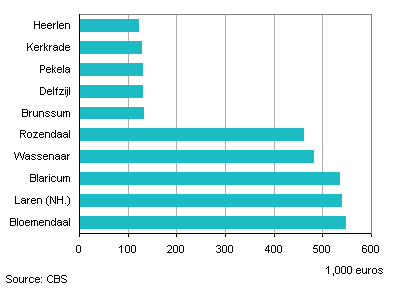WOZ value dips under 2007 level

On 1 January 2014, the average value of houses based on the Land and Property Appraisal Act (WOZ) was more than 5 percent down from 2013. Currently, the average house price in the Netherlands is 211 thousand euros, which is below the level recorded in 2007.
WOZ value dramatically down in 2013
The WOZ value peaked in 2010, reaching an average level of 242 thousand euros. Subsequently, the WOZ value began to decline; with 5.4 percent, the most substantial decline was recorded in 2013. The average WOZ value of residential property is currently just below the level of 2007.
Vast regional differences
With 249 thousand euros, the province of Utrecht accounts for the highest average WOZ value, followed by the provinces of North Holland and North Brabant with 235 thousand and 232 thousand euros respectively. The lowest average WOZ value was recorded in the province of Groningen (159 thousand euros). The depreciation rate of the WOZ value ranged from 6.6 percent in the province of Friesland to 1.1 percent in the province of Zeeland.
Municipalities with highest and lowest average WOZ values, 2014

The differences are even larger on the municipal level. In the municipalities of Bloemendaal, Laren and Blaricum, the average house value exceeds 500 thousand euros and is lowest in the municipality of Heerlen (123 thousand euros). Five of the ten municipalities with the lowest WOZ values are situated in the province of Groningen and three are in the province of Limburg.
WOZ value followsresidential property prices
The WOZ value follows the price developments of owner-occupied houses (excluding new constructions) with a delay of approximately twelve months. The delay is due to the fact that houses belonging to the Dutch dwelling stock are appraised on 1 January of each year on the basis of the value on 1 January of the previous year. Residential property prices reached the highest level in 2008 and subsequently began to fall. The WOZ value still increased in 2009 and started to decrease in 2010. Prices of owner-occupied dwellings dropped most dramatically in 2012, followed by the most substantial reduction in WOZ value one year later. At the end of August, Statistics Netherlands reported that prices of owner-occupied dwellings had risen for four months in a row.
WOZ values and prices owner-occupied houses

Apart from the reference date, WOZ value and house price developments are not entirely identical. There are various reasons for the difference. Firstly, the WOZ value covers all houses in the Dutch dwelling stock, including the rentalsegment of the housing market. Secondly, the amount of dwellings varies continually as a result of new constructions being added to the dwelling stock and demolitions. In general, this has a positive effect on the WOZ value.
Bert Bunschoten